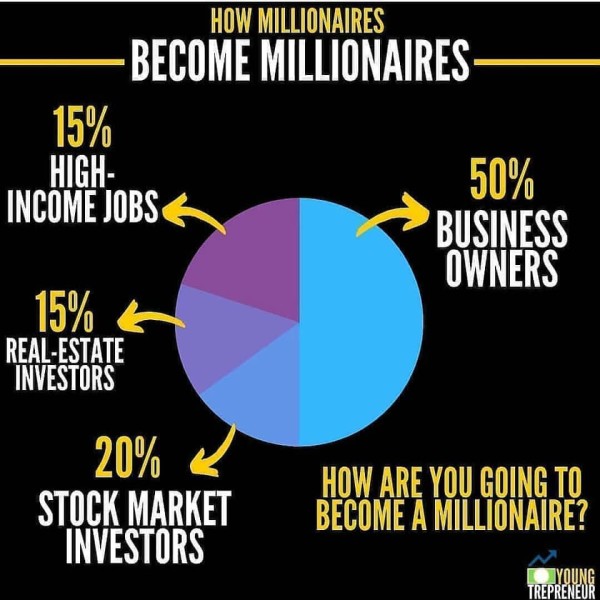Many people ask “how to become a millionaire” but many people have no idea where to begin. Hopefully studying other people that have made this milestone will help us answer this question. The jnforgeaphic below tries to settle this question by giving statistics from how most people made their millions.
15% of millionaires became so by having high income jobs. A modest and doable path, but without strong connections and education, most would most likely fail. The other 15% became millionaires through real estate. This makes sense since many people can leverage real estate. This seems like the most likely path for the average person. The other 20% became a millionaire by the stock market. Doable if one is investing in indexes, but probably a large amount of luck is needed for individual securities. Finally, the last 50% became millionaires by starting a business.
It seems like starting a business is your best chance to become a millionaire. What are your business ideas?
Related posts:
Just where did all the money goes? Easy credit, no cash no porblem. Debt turns toxic take out a loan on a house, this is one of the most basic tools of finance.
What beyond car insurance? Weird insurances, this is a policy normaly cost $150 per $1.5 million in coverage as of 1998 it is called alien abduction. $125 for celebration interruptus. This is for cancellation or postponement coverage.50$ cork fly in the cellar.In Ransom reimbursement, high profile people would pay about $2500 to $10,000. For rained out, $404 and for Disability coverae for stallion...
Regardless of what your doing on the internet, privacy and security should always be one of your primary concerns. While TorrentGuard is focused on making bittorrent anonymous it is also a fully functional VPN to keep all your internet activities private and secure.Torrentguard is a leader in the online security industry – is proud to renew its commitment to defeat every online threat via the laun...
The money was made from one cow. Cow weigh 1,100lbs before slaughtering. 500lbs are edible so 112lbs of this is used for hamburgers.This equates to roughly 450 quarter pounders.The cow was cost $600 but the average price for a McDonals quarter pounder is $3.45.So if we multiply $3.45 x 450 (in one cow) total is $1552.5.Last 2005 McDonals claimed that they sell 75 burgers per second of every minute...
Find out everything you need to know about wearing Regalia, what it’s meant for, what makes it so special, and the common types of Regalia. As a long established tradition throughout the world, Regalia is more than just an accessory, it expresses some degree of exclusivity that members of an organization are proud to be a part of.
Inflation can be complicated, it is when stuff costs more.When inflation is often villified, it is more complicated that that. That is generally the case, although there are other indices being measured as well.So, do you think inflation is bad? It can be bad, but it depends on the situation. inflation workds to out advantage, but too much inflation cant be good.


 Upload your infographic here and contribute to our community.
Upload your infographic here and contribute to our community. 
Leave a Reply